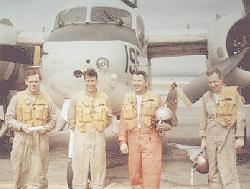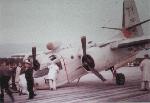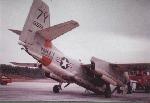|
And They Walked Away By:
Hal Neubauer in collaboration with Dave Wiza While the human factor can be the source of many serious incidents, it can also be the solution, turning a potential disaster into a minor incident. This is a story of just one such incident. While most of us tend to
look back with favor on our experiences while serving in the military, we tend
to forget many of the boring and unpleasant tasks we encountered. For the
crewmen in an S2F one of those boring events were cross-country flights. In
those situations only the radar operator had the potential for some activity and
frequently the pilot didn't want the radome extended during a cross country so
boredom was inevitable. One Aviator with hundreds of hours described it this
way. "Flying is hours of boredom, interspersed with moments of stark
terror."
Personally I would agree
with his definition of flying, in many situations. The only saving grace was the
prospect of liberty at the end of a cross-country flight in a different than
normal setting. At the end of a two-week
cruise in 1959, like so many others before, an S2F crew set off from Guantamo
Bay, Cuba on a cross-country flight to Atlanta, Georgia with the ultimate
destination Grosse Ile, Michigan. Navy Atlanta was a favorite interim
destination. They landed with out incident and the crewmen refueled the plane
while pilots went to operations to file their flight plane for the second leg of
their flight. After getting airborne one of the pilots wanted to check the
charts and they discovered they had left the nav bag in Atlanta Ops. The crew on
this flight was Lcdr. Sam Napolitano, copilot Lt. Tom Benson, crewmen Donald
Fitch AO2 and David Wiza AMS2. Returning to Atlanta to retrieve the Nav bag,
they dumped the gear on final and failed to get a green light on the nose gear.
They took it around and exercised the gear repeatedly but failed to get a safe
indication. Occasionally indicators fail to function so a visual is called for.
This is normally accomplished with a fly-by so the tower personnel can get their
glasses on the aircraft and determine if the nose gear is actually down but not
necessarily locked. In this case it was not down. Several hard
“touch-and-goes” were made to try and jar the nose gear lose with out
success. The emergency procedure
for release of the nose gear requires that the crew to raise the center console,
cut into the floor of the cockpit with an emergency axe provided for such
events, and manually release the nose gear. The first two steps were
accomplished with out incident but with a slight twist. The aircraft did not
have the emergency axe which is a normal part of the flight equipment required.
So, the ever-present survival-knife carried by all aviators was employed to cut
through the flight deck. However, once accomplished, the nose gear could not be
released manually after it was exposed. A number of ideas surfaced and were
discussed in the hours they circled Atlanta to burn fuel. One included
attempting to put the nose on the bed of a speeding truck racing ahead of the
plane as it landed. Apparently, Atlanta had a very long runway compared to
Grosse Ile. Two real options remained. Bail out or ride it down. Most fliers
will tell you never abandon a perfectly good plane when all engines are
operating unless, of course, it’s on fire. At sea that would have meant a
ditching. In reality, the first option (bail out) only applied to the crewmen.
After some discussion of the pros and cons of each option, Napolitano allowed
the two crewmen to make their own decision. They chose to ride it down as a
crew. It is not clear how much
time elapsed from the time they attempted their first landing until the real
thing. But, they had burned most of their fuel when they attempted their
controlled crash. To minimize the potential
for injury and damage they feathered the starboard engine. Positioned the
3-blade prop to provide maximum clearance between it and the ground. With the
two main landing gears in the green and the nose wheel fully retracted they
touched down. Once firmly on the ground they feathered the port engine. While
one pilot held the nose high the other positioned the port prop so it to would
have maximum clearance to the ground once the nose was allowed to fall through.
Your friendly crash crews greeted them once the plane came to a halt on the
runway. And a welcome sight they are in such circumstances. The crew exited with
haste but no fire occurred. The human factors in this situation took a
relatively serious incident and turned it into a relatively minor incident. The
result was no personal injuries, no prop damage, no engine changes required, and
no major structural damage. It was necessary to repair the floor of the cockpit
and the outer skin of the nose as well as repair the nose gear it self. All of
which was considered relatively minor under the circumstances. The Grosse Ile
Station Keeper in charge of the S2F line wasn’t too happy that they had messed
up the deck in the cockpit and were still unsuccessful releasing the nose gear.
When the crew was returned to NFB by R4D, they were treated somewhat as heroes.
Later this crew would be activated when VS 733 was recalled to active duty. They
were relatively inseparable and today CDR. Napolitano (retired) speaks of his
crew only in the most glowing terms. Donald Fitch is the only member of the crew
that has not been in contact with any one in recent times.
To say "flying is hours of boredom,
interspersed with moments of stark terror" is no understatement in this
case. And according to Dave Wiza, “Just for the sake of the record, there is a
pucker factor”. |




